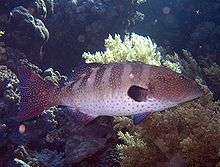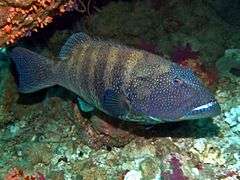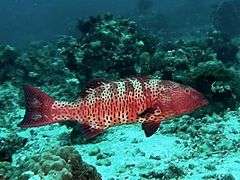Roving coral grouper
| Roving coral grouper | |
|---|---|
 | |
| Scientific classification | |
| Kingdom: | Animalia |
| Phylum: | Chordata |
| Class: | Actinopterygii |
| Order: | Perciformes |
| Family: | Serranidae |
| Genus: | Plectropomus |
| Species: | P. pessuliferus |
| Binomial name | |
| Plectropomus pessuliferus (Fowler, 1904) | |
| Synonyms[1] | |
|
List
| |
The roving coral grouper (Plectropomus pessuliferus) is a species of fish in the family Serranidae. Other common names are violet coral trout and leopard grouper.[2]
Subspecies
Subspecies include:[2][3][4]
- P. p. marisrubri Randall & Hoese, 1986 (Red Sea)
- P. p. pessuliferus (Fowler, 1904) (the rest of the Indo-Pacific region)
Distribution and habitat
This widespread but quite rare species can be found in the Indo-Pacific, from the Red Sea to Fiji (Djibouti, Egypt, Eritrea, Indonesia (Bali, Java and Sumatra), Israel, Jordan, Mozambique, Saudi Arabia, Sudan, Tanzania, Tonga, Zanzibar, Maldives, Laccadives, St. Brandon's Shoals, Sri Lanka, Chagos, Nazareth Bank, and Fiji).[2][3] These fishes live in coral reef, in shallow lagoon and seaward reefs, at a depth range of 25 – 147 m.[2][3]
Description
P. pessuliferus reaches a maximum length of 120 cm (in the Red Sea) and at least 63 cm (in the rest of the Indo-Pacific).[2][3] These large fishes have massive bodies and heads with prominent eyes and characteristic large jaws and lips. Their pectoral and caudal fins are darker, sometimes brown, spotted with blue dots. They have very variable colors, from white or beige to red, with large, irregular, vertical, grayish bands. The whole body is covered with blue dots. They have seven to nine dorsal spines, 10-12 dorsal soft rays, three anal spines, and eight anal soft rays.[3]
This species is rather similar to and often misidentified as Plectropomus maculatus.[3]
 P. p. marisrubri
P. p. marisrubri P. p. marisrubri
P. p. marisrubri
Biology
This carnivorous species mainly feed on fishes and crustaceans.[2] They sometimes engage in cooperative hunting with the giant moray (Gymnothorax javanicus), the humphead wrasse (Cheilinus undulatus), or the big blue octopus (Octopus cyanea).[5][6][7]
References
- ↑ WoRMS
- 1 2 3 4 5 6 IUCN
- 1 2 3 4 5 6 Fishbase
- ↑ Biolib
- ↑ Bshary R, Hohner A, Ait-el-Djoudi K, Fricke H (Dec 2006). "Interspecific communicative and coordinated hunting between groupers and giant moray eels in the Red Sea". PLoS Biol. 4 (12): e431. doi:10.1371/journal.pbio.0040431. PMC 1750927. PMID 17147471.
- ↑ Vail A.L., Manica A., Bshary R., Referential gestures in fish collaborative hunting, in Nature Communications, vol. 4, 2013.
- ↑ Il pesce che quando va a caccia "balla" per chiamare rinforzi in National Geographic
Further reading
- Heemstra, P.C. and J.E. Randall, 1993. FAO Species Catalogue. Vol. 16. Groupers of the world (family Serranidae, subfamily Epinephelinae). An annotated and illustrated catalogue of the grouper, rockcod, hind, coral grouper and lyretail species known to date. Rome: FAO. FAO Fish. Synop. 125(16):382 p.
- Nouguier, J. and D. Refait (1990) Poissons de l'Océan Indien: les Iles Maldives., Réalisations Editoriales Pédagogiques, Paris. 304 p.
- Randall, J.E. and C. Anderson (1993) Annotated checklist of the epipelagic and shore fishes of the Maldives Islands., Ichthyol. Bull. of the J.L.B. Smith Inst. of Ichthyol. 59:47.
- Randall, J.E. and P.C. Heemstra (1991) Revision of Indo-Pacific groupers (Perciformes: Serranidae: Epinephelinae), with descriptions of five new species., Indo-Pacific Fishes (20):332 p.
